This project also contributes significantly toward our aspirations to open a new gateway to Colonial Williamsburg for those who visit, ushering in a vibrant next century for the Foundation and our guests.
Colonial Williamsburg’s iconic Goodwin Building was officially dedicated over 80 years ago on January 21, 1941. Named after Rev. Dr. W.A.R. Goodwin, the building originally housed the Restoration administrative staff with room for shops below. In the years since, the Goodwin Building became the official headquarters of Colonial Williamsburg, with administration staff and leadership offices providing an ever-present feel in what we now call Merchants Square.
This project also contributes significantly toward our aspirations to open a new gateway to Colonial Williamsburg for those who visit, ushering in a vibrant next century for the Foundation and our guests.
Sometimes referred to as “the father of the Restoration of Colonial Williamsburg,” Rev. Dr. Goodwin is credited as the inspiration behind Colonial Williamsburg, convincing John D. Rockefeller Jr. and his wife Abby Aldrich Rockefeller to help restore the historic town as a living history museum. By the 1940s, the construction of the Goodwin Building became a necessity to house the Restoration offices.
At the time of its construction, the Goodwin Building was the largest single project undertaken with fluorescent lighting fixtures and the largest-yet air conditioning system in all of Williamsburg being interior focal points for this exciting new venture. Located on the corner of North Henry Street and Prince George Street, the two and a half story American-Federal style building was constructed in an H-shape with dormered central section of red brick, two painted white brick wings and twelve chimneys. The H-shape allowed for a large building with corridors on the same level and space for shops below that maximized its presence in the area without overwhelming the surrounding buildings. In modern-day Merchants Square, the building retains its presence while contributing to the design integrity of the surrounding area.
The renovation of the Goodwin Building will be undertaken with great care, accommodating modern infrastructure that will position the Foundation for the next century while also ensuring the architectural and historical integrity of the building remains intact.
During the renovation, electrical, plumbing, heating and air conditioning systems will be evaluated and updated, features like the elevator will be examined and brought up to code as necessary and the masonry and chimneys will be repaired. The renovation will provide technological needs that staff require and guests expect while the renovated building returns to the prominence of its earlier days in Williamsburg.
As we approach the Foundation’s centennial, now is the time to seize this opportunity and restore this building that has played a defining role for over eight decades. In the years leading up to 2026, we are constantly re-evaluating and challenging our work to ensure we are sharing a more complete and relevant story of America’s founding. Relocating staff and leadership to the confluence of the Historic Area and Merchants Square will better connect the entire Foundation, from interpreters to accountants to the president. It will also free up critically needed space in the Bruton Heights School for other areas of the Foundation, including Information Technology.
Reinvigorating the Foundation and this historic building that has held significant prominence in Merchants Square for so many years offers a better connection between our guests, employees and leadership team. We appreciate your support of this important and historical initiative.
For more information, contact campaign@cwf.org
